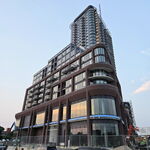The main issue with small units is that storage is lacking. We recently bought a bigger unit than what we had from a low-rise developer who is converting old brown-stone duplexes into stacked low-rise flats. Family sized units (1100 sq ft+) for 2+den (proper den - window, door, could be baby room)/3 bedrooms in nice areas of the city: circabuilt.ca
The main advantage is low CEF (more of a town house feel). The build quality is superb - built to luxury home standards. Custom kitchens and custom storage in closets (this is a big plus in condos).
This is what they call the missing middle. Toronto should encourage more of this type of buildings. They are on the upper end to build but the maintenance is a lot lower compared with high rises as there is no security, no management on site and not elevators or expensive elements to maintain.
I can't agree with storage being the main issue as storage can be bought or built-in (via clever double duty furniture or IKEA type cabinetry). And, if you're going custom, a good designer knows many tricks.
When we downsized, we went from a large eat-in kitchen (approx. 200 sf) to the current 63 sf. But we employed all sorts of tricks in the kitchen when we designed the custom cabinetry. For example, we went with 14 inches deep instead of the standard 12, and we ordered 16 inches from counter top to bottom of upper cabinet which is standard 18. The cabinets go all the way to the ceiling which makes the entire space look bigger. It is amazing how much more storage that gave us in the kitchen. Add a bunch of what I call "kitchen porn" -- yeah, I get off on kitchen catalogues -- and you're done. I'm talking sliding racks, "kidneys," L-shaped drawers for tight corners, etc.
Ditto the bathrooms which are small here this being an older building.
I see the problem with small, newer units as being bad layouts and wasted space: long hallways too narrow to build in shelf space on the sides for example. Oversized bathrooms but tiny bedrooms. I guess it's because developers want to cram as many units as possible on to a floor and younger buyers are impressed by double sinks? I don't know.
I totally agree with the missing middle idea. I am not doing the Montreal-is-better-thing here but the city was, until about a generation ago, much denser than TO, thanks to (among other builds) four-plexes: i.e. semi-detached stacked flats, the kind you see in the Beaches and around/off Avenue Rd. south of Eglinton. Some of these places in Montreal are very luxurious, beautifully built (mostly in the 1920s) with huge rooms, stunning architectural details. Then there are the older three story triplexes (usually attached) on the Plateau and lower Outremont. Mordecai Richler territory, often with Montreal's distinctive wrought iron external staircases (which always terrified me.)
People would buy the building, live upstairs (or downstairs) and rent out the other suite(s). When the Boomers started looking for houses in cooler, older parts of town, many of these started becoming co-ops. People would buy a building with friends. One family upstairs, the other downstairs. Eventually, some kind of legal set-up was created so units could be bought and sold independently.
Sometimes the buildings come renovated with separate furnaces, hot water tanks and hydro panels. Sometimes not. But, because these flats are typically 1500+ per floor, there is usually plenty of room to muck about in the basement.
Here's a video of a recent listing which, as it turns out, is two blocks down the hill from our own (former) lower flat which had a small garden, underground parking, 3 BR upstairs and a high finished basement below. The woodwork in this listing has been painted over, and the sale appears to be for all four flats, upper and lower on both sides. I am guessing that this duplex was likely built c. 1918-1925.
It's because of housing like this that I feel families can indeed live comfortably and affordably in apartments in town.




